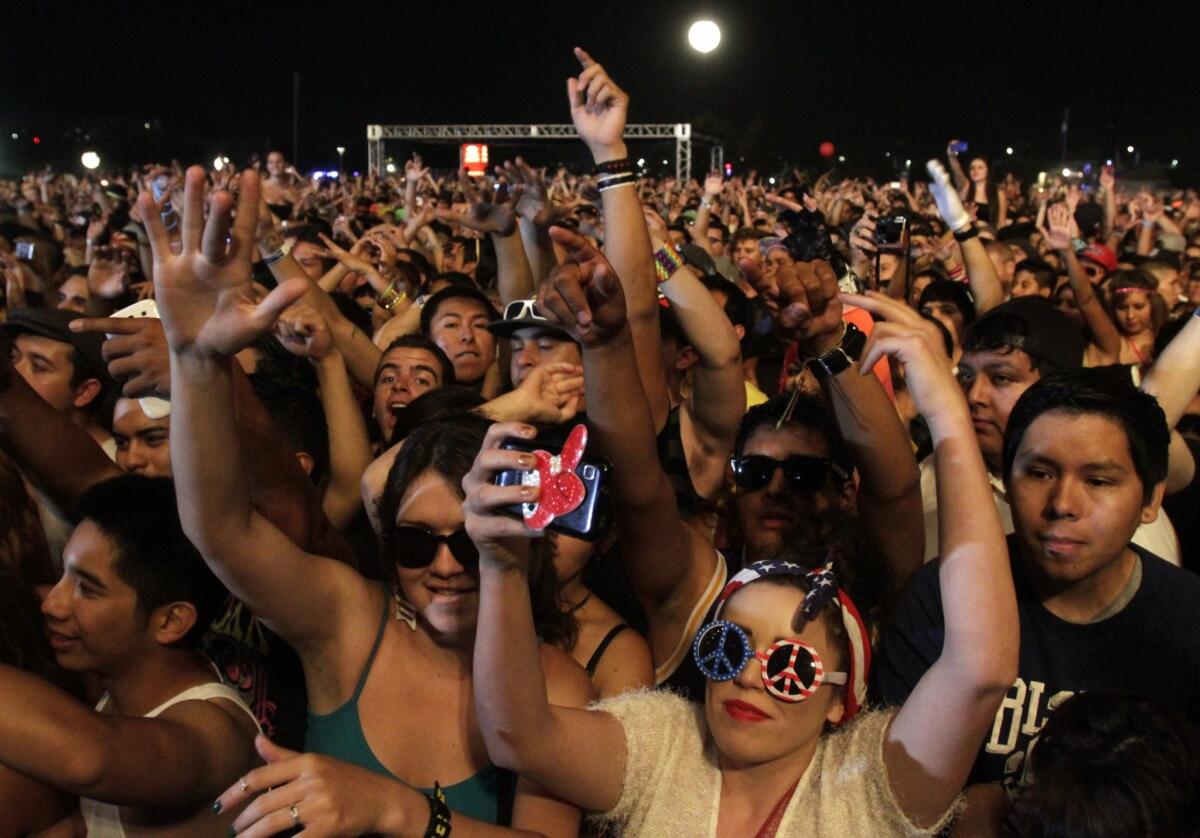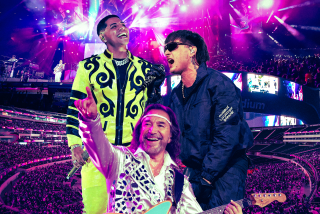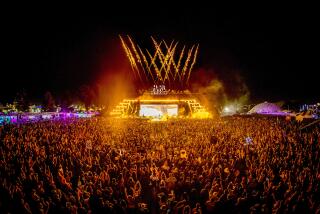Los Angeles’ EDM explosion powers its move toward dance dominance

- Share via
It’s arguably never been a better time to be a dance music fan — or in the dance music business — in Los Angeles than right now.
The annual Hard Summer festival this weekend will draw an estimated 70,000 electronic music fans over two days to L.A. State Historic Park in Chinatown, with major acts such as Justice, Dog Blood and Knife Party. Alongside it, the city is experiencing a surge in new, EDM-focused nightclubs. At least six major venues have opened or revamped in the Hollywood and downtown areas in the last two years, including the 1,700-capacity Exchange L.A. along with Create, Sound, Lure, Greystone Manor and A.V.
They join a field of established clubs like Avalon, smaller dance-focused bars like Pattern Bar and roving parties like A Club Called Rhonda, and a galaxy of semi-legal warehouse parties along downtown’s fringes. In addition, L.A. arenas and festivals such as Coachella are increasingly finding that dance acts are filling their floors, and in the last year Live Nation has invested in or acquired L.A.’s two largest independent dance promoters, Hard Events and Insomniac.
Rarely has so much seed money, talent, and interest coalesced around a single genre the way that Southern California has embraced electronic dance music in the past few years. In both sheer numbers and quality, L.A. is finally equaling U.S. cities like New York and Miami, and it has the momentum to eventually become a world-class dance music tourism city.
PHOTOS: Hard Summer music festival 2012
“L.A. has such huge potential as a destination for dance music,” said Rob Vinokur, co-owner of Sound (which made Rolling Stone’s list of America’s 10 best dance clubs) and nearby venue Playhouse. “I’ve lived in every major cosmopolitan city in the U.S., and we almost have it here.”
But not far away in Las Vegas there’s also talk of a dance music bubble bursting, after the $100-million club Hakkasan and Cirque du Soleil’s EDM venue Light entered into an already crowded and expensive field. L.A. also faces particular transportation and regulation challenges in growing its night life scenes.
At this juncture, it’s worth asking — what’s the right path to a sustainable dance music infrastructure in L.A.?
“I always believe that the cream rises,” said Gary Richards, CEO of the promotion firm Hard Events and a DJ who performs as Destructo. “Last year we almost doubled, and we could have sold 10,000 more tickets to this year’s Hard Summer if we’d wanted to. But there are too many people just milking this stuff. My interest is just in making everything work better.”
PHOTOS: Hard Summer music festival 2011
The world’s great dance music cities all share certain traits. There’s a mix of must-see nightclubs (like Berlin’s Berghain or London’s Fabric) and marquee festivals (Miami’s Ultra Music Festival or Electric Daisy Carnival in Las Vegas) that set a global agenda and draw hundreds of thousands of fans.
Hard Summer is rapidly becoming L.A.’s standard-bearer for the latter. After the departure of L.A.-based Insomniac’s Electric Daisy Carnival to Las Vegas (after a teenager’s overdose death in 2010), Richards’ firm has grown to host the dominant dance music festival in L.A. His stable includes events such as Hard Summer, Hard Day of the Dead (a smaller festival held in the fall) and the EDM cruise Holy Ship, alongside a variety of club-level events across America.
Hard festivals have helped launch big new stars like Skrillex, and the firm earned a major endorsement when Live Nation acquired Hard Events in 2012 (terms of the deal have not been disclosed). Seven years after Hard Events’ founding, this year’s fest is the biggest installment yet.
“The key is the music, you have to be diverse and pick new things,” Richards said. “Any promoter can just go book the DJ Magazine top 100 acts. People are tired of seeing all that same stuff.”
Local festival-sized competitors, like the long-running Lightning in a Bottle, are improving to compete. And a new L.A. edition of the dance-focused conference International Music Summit, held in April at Hollywood’s W hotel with speakers like Ultra Records’ Patrick Moxey and Shelly Finkel from promoter SFX Entertainment, offers a forum to debate the genre’s business issues.
The economic effects of such festivals are real. 2012’s Electric Daisy Carnival brought more than $200 million into the Las Vegas area, according to a Beacon Economics study. This year’s two-week Ultra Music Festival brought an estimated $79-million worth of economic activity to Miami-Dade County — an area with one-third the population of Los Angeles County.
But to truly take on other cities for money and influence, there needs to be a year-round EDM club ecosystem that falls outside the summer festival season..
L.A. has rapidly caught up in the last two years. New clubs like Insomniac’s Exchange L.A., Create (Insomniac’s venture with hospitality conglomerate SBE) and SBE’s Greystone Manor routinely sell out bills with the genre’s top artists. Stalwarts such as Hollywood’s Avalon and well-appointed upstarts like Sound and Lure keep a heady mix of mainstream fare and more adventurous artists.
TIMELINE: Summer’s must see concerts
“There’s so much money coming in, but mostly the balance is healthy,” said Andrei Osyka, the founder of the downtown Standard Hotel’s Culprit Sessions Sunday pool parties and a member of the experimental house trio Droog. “The underground is flourishing, and there’s no reason to resent what’s happening on a mass scale.”
Not all these places will survive. Ever-rising DJ fees — top acts like Kaskade can reportedly command well over $200,000 for a show — and the now-requisite explosive sound systems and lighting effects mean that just getting into the EDM club racket can cost millions. The recent run of new clubs and festivals with radius clauses creates bidding wars for talent, making it even harder to pay bills. And dance fans are famously fickle.
“The scene grows, there are more venues and opportunities, and then fools rush in,” said John Lyons, the sound-system designer and owner of the Hollywood dance music institution Avalon, which has set the pace for the genre in L.A. for the last eight years. “There will be a correction. How do I politely say this? Some of these places are obviously short-term plays.”
Despite L.A.’s appeal for dance fans and artists — perpetual sunshine and access to the larger music industry infrastructure a part of it — Southern California has its own unique dance-culture challenges.
PHOTOS: Best albums of 2012 | Randall Roberts
A car-centric transportation system is a burden on fans who want to drink, and our public transit system is just beginning to accommodate late-night club-going.
Hard Events has made particular headway in that regard. Metro’s first 2010 experiment in extending rail hours to accommodate Hard Summer proved successful and popular. Now Hard Events estimates that 40% of Hard Summer patrons take public transit, and Metro’s rail lines run until just after 2.a.m. every Friday and Saturday. “I think we turned a lot of people onto Metro, and I’m so happy about that,” Richards said.
Hard Events will face a new obstacle when L.A. State Historic Park closes for a year of renovations in 2014 (Richards said it is already considering several sites near downtown to pinch-hit). But more importantly, California’s 2 a.m. last call is the biggest hurdle for maintaining a profitable dance club in L.A.
It’s the most common complaint among anyone in the L.A. dance-music business — missed hours of beverage sales, missed cover-charge-paying bodies through the club doors, and missed opportunities to draw top-tier international talent expecting to play late into the night or even morning.
PHOTOS: Iconic rock guitars and their owners
Even though some local clubs can remain open later without serving alcohol, the costs are significant: Las Vegas megaclubs like the 3,500-capacity Marquee can boast $80 million to $90 million in gross revenues a year, according to the trade journal Nightclub & Bar. All of America’s top-10-grossing venues are in Las Vegas, New York or Miami.
The highest-grossing L.A. nightclub, the 700-capacity Greystone Manor, topped out between $25 million and $35 million last year, placing it at 11th. Avalon was 19th, and most other top L.A. clubs are well below that (though the 1,500-capacity, newly revamped Create may become a contender soon).
When clubs in cities like New York, Miami and Chicago (let alone Las Vegas) can serve alcohol until 4 a.m. or later, California’s last-call law becomes a liability not just for a club’s bottom line but its ability to buy the best talent.
“A DJ has a set fee to perform. I have three hours less to serve alcohol than Miami, and Vegas is serving for 24,” Vinokur said. “This is Hollywood, the city of entertainment, and it’s still difficult to compete with these other cities.”
TIMELINE: Coachella and Stagecoach
Some politicians and regulators are taking note of the missed economic opportunities. This year state Sen. Mark Leno (D-San Francisco) introduced a bill, SB-635, that would have allowed local jurisdictions to submit a plan before a public forum and the state Alcoholic Beverage Control to allow alcohol service until 4 a.m.
“Every major city in the country outside of California has some kind of extended-hours service, as does almost every major global city,” Leno said. “There’s nothing radical about this bill.”
The bill died in committee, and groups such as MADD that advocate more restrictive alcohol policies opposed it. But the bill earned support from mainstream business groups like the California Restaurant Assn., and Leno thinks the economic arguments for it (and a fair-minded assessment of its risks) will eventually turn in its favor — perhaps on a later statewide ballot initiative.
In the meantime, the 70,000 fans hopping a late-night Metro or driving down to Hard Summer probably know they’ve never had it so good. L.A. doesn’t have to be like Las Vegas — and it’s almost certainly better for the dance music culture that it isn’t trying to be.
“All the artists want to come live in L.A.,” Richards said. “My partner at Live Nation is from Liverpool, and now he’s in Beverly Hills. Who wouldn’t want to be here instead?”
---------------------------
Hard Summer
Where: Los Angeles State Historic Park, 1245 N. Spring St., L.A.
When: Noon Sat-Sun.
Price: $85-$159 (sold out)
Top acts: Disclosure, TNGHT, Gesaffelstein, Julio Bashmore, Flying Lotus, Breakbot, Dog Blood, Justice, Empire of the Sun, Claude Von Stroke
Info: hardsummer.com
More to Read
The biggest entertainment stories
Get our big stories about Hollywood, film, television, music, arts, culture and more right in your inbox as soon as they publish.
You may occasionally receive promotional content from the Los Angeles Times.








